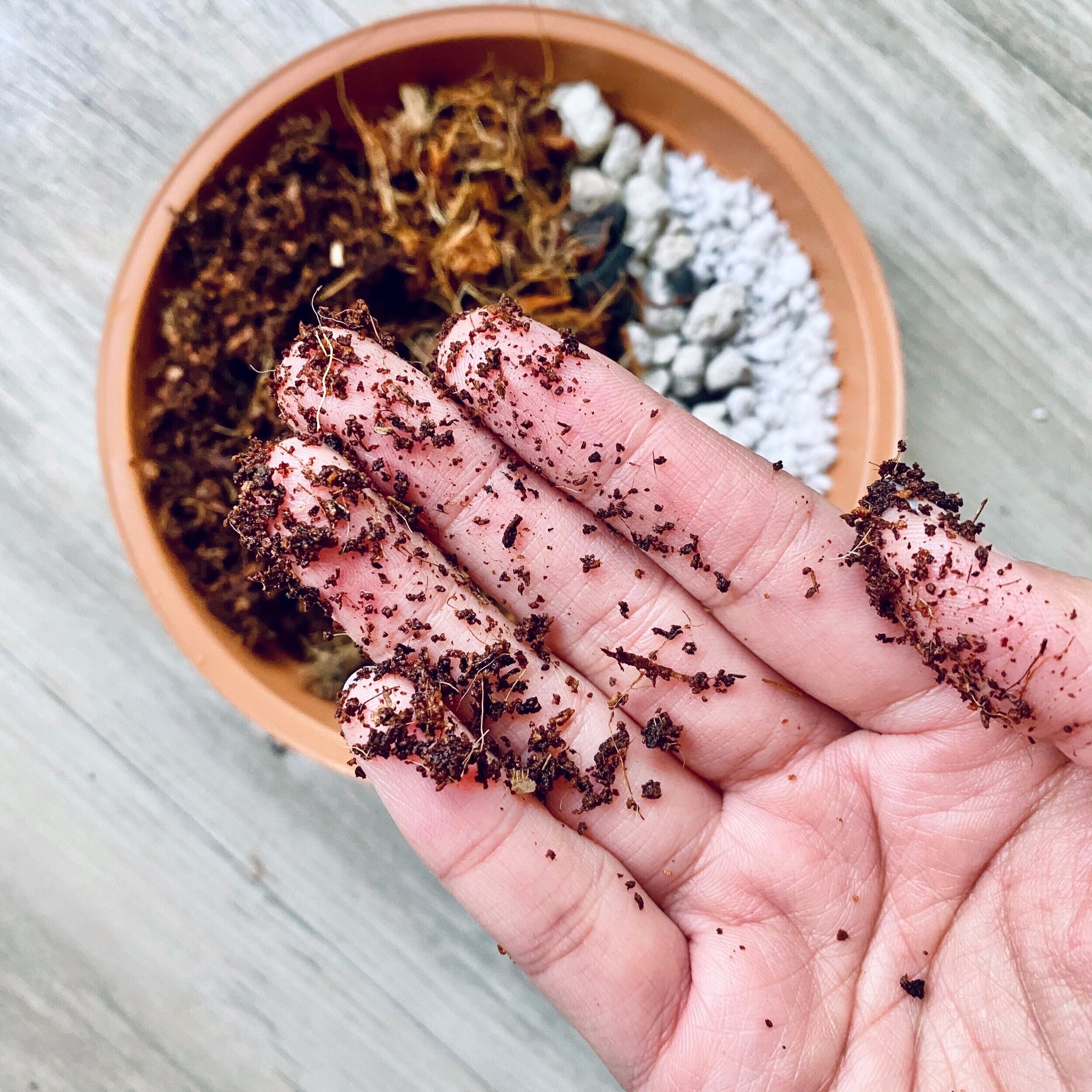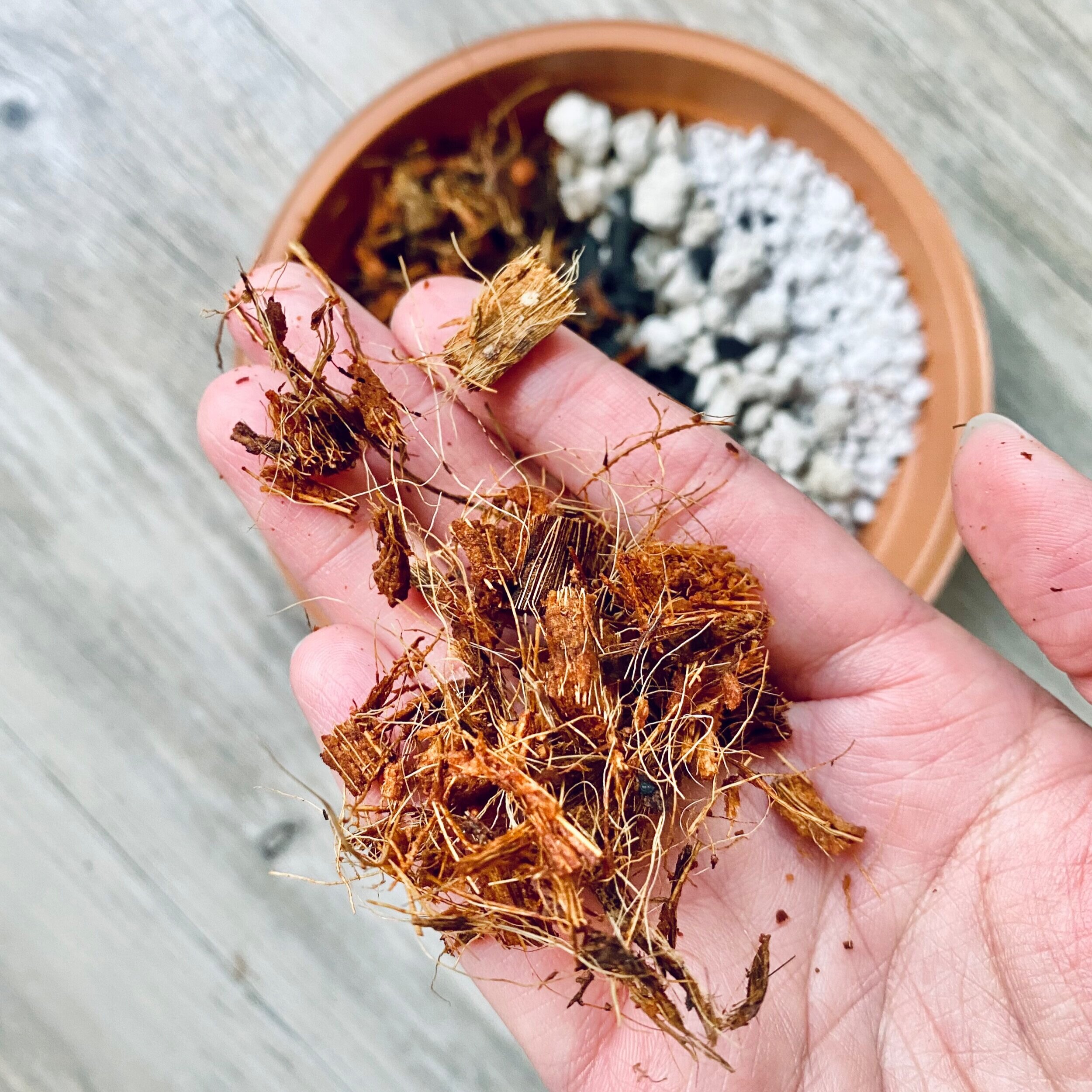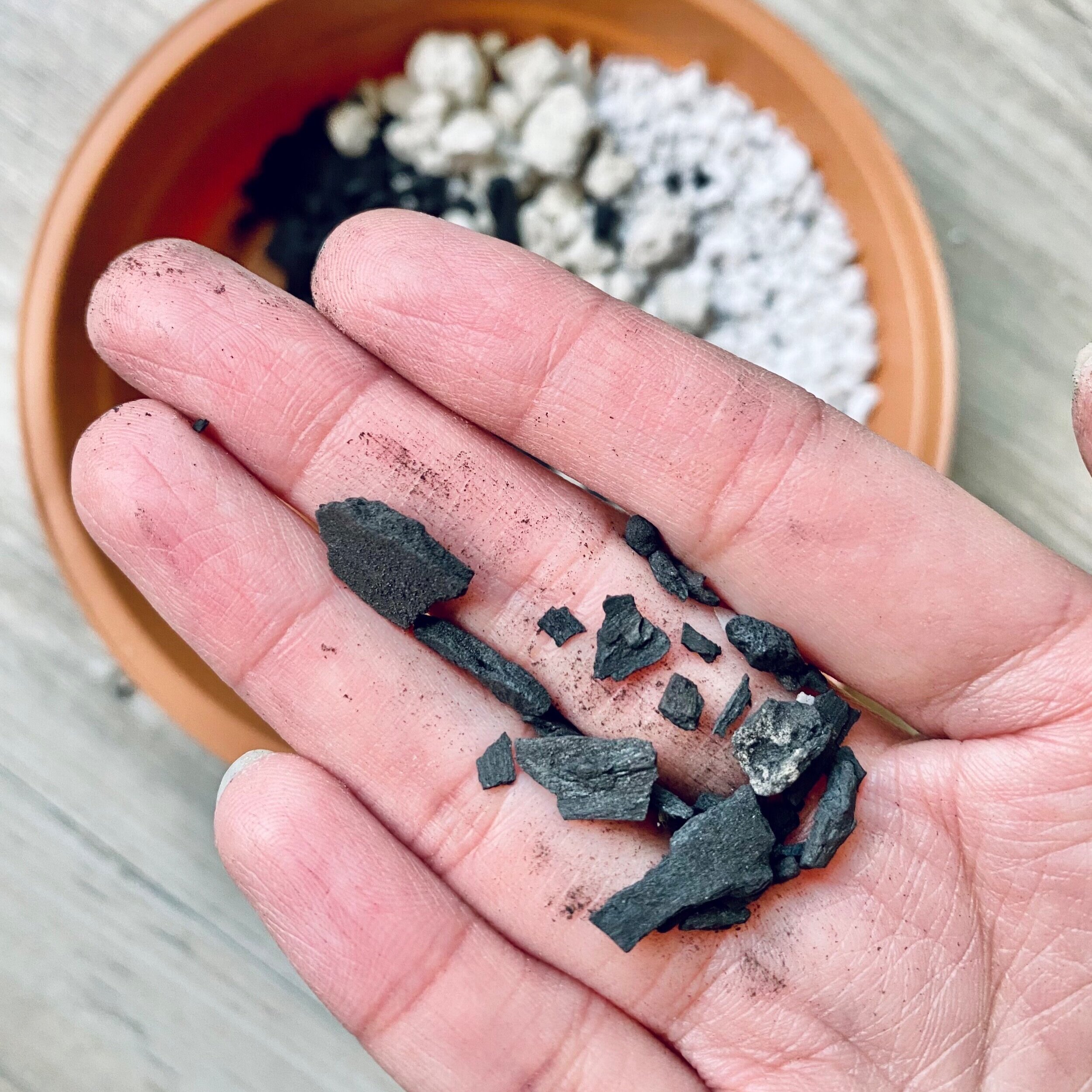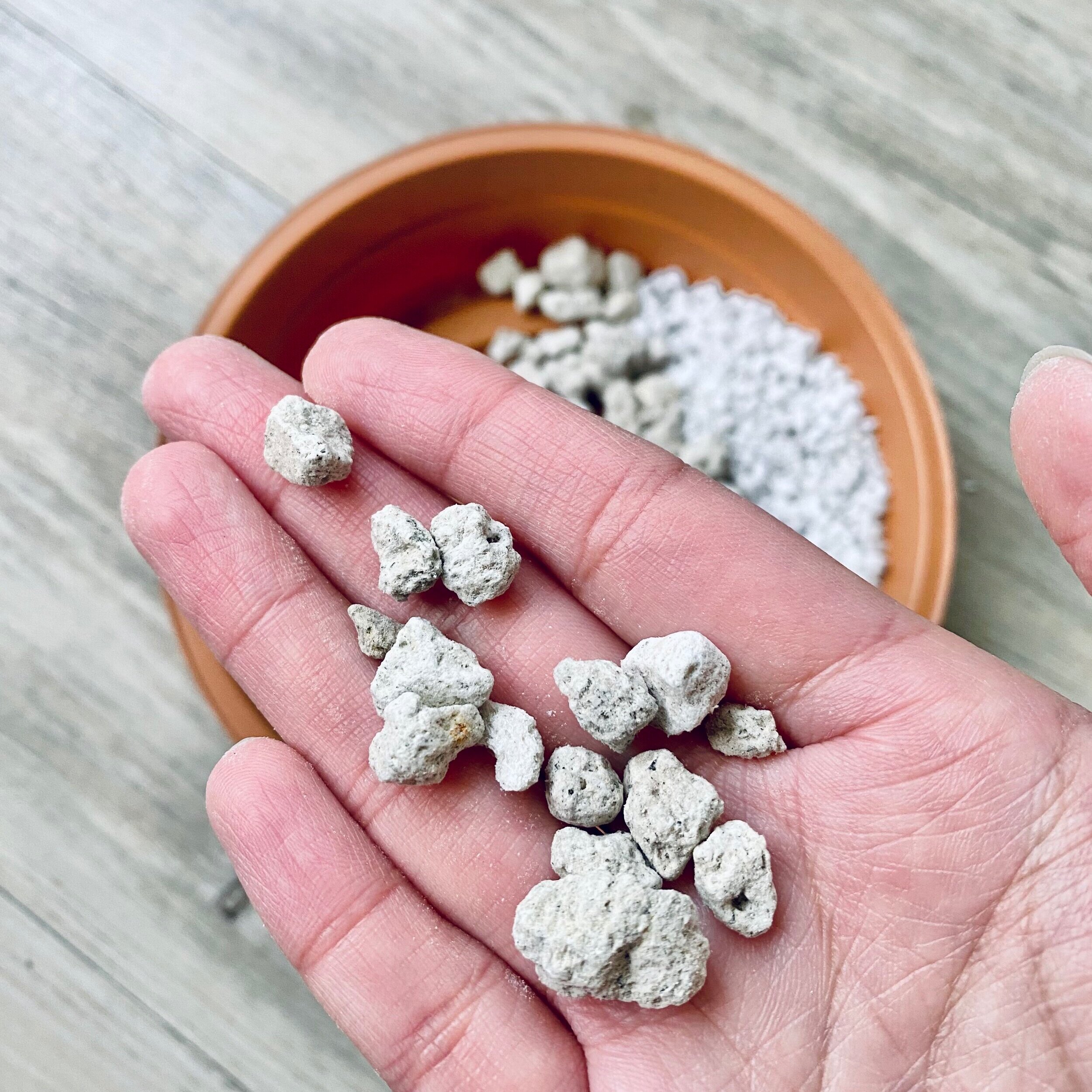The Ultimate Guide to Houseplant Substrates
My Hoya mix
As I ventured deeper into my houseplant hobby, away from easier, common plants found at big box stores and into the world of rare aroids, I realized that there was another world beyond Miracle-Gro potting mix. My experience with Miracle-Gro was generally positive, but further research taught me that some plants have different needs.
Although a plant might be fine with a standard potting mix, it might thrive in a thoughtfully concocted custom mix. A substrate is the ground cover for your plant’s root system, and there are many options to consider. The optimal substrate depends on the houseplant you’re potting.
Substrate considerations
Substrates are also referred to as “medium” or “media”. It helps plants regulate water and offers roots something to hold onto so the plant is stabilized. It also helps protect the root system from harsh conditions and retains nutrients for plants to take up.
Two important considerations when choosing substrate is how much water retention and air circulation it offers the roots. Here’s a list of substrates that I’ve personally worked with or have researched in detail.
Substrates for water retention
Soil
Soil is what you might think of as “dirt”. It’s a combination of organic matter (dead or alive), minerals, gas, and water. It offers the same support as other water-retaining substrates, giving plants support, and helping with water, nutrient, and air regulation. However, soil is a heavier substrate and might not offer the same kind of air circulation as other mediums.
Peat moss
Peat moss, also called sphagnum peat moss, is an organic medium that has low pH which acid-loving plants enjoy. It’s mostly composed of dead moss and other decayed material. Peat moss is an ingredient commonly found in pre-packed potting mixes, like Miracle-Gro’s potting mix and other brands. It’s a lightweight substrate that can hold onto more than its weight in water (and soluble nutrients or fertilizer).
Since it easily retains a considerable amount of water, it’s not ideal to use it alone. Doing so could hold too much water around the root system and lead to root rot (which, if not caught early, can mean a swift death for your plant). Instead, peat moss is often mixed with other substrates to balance out this function with aeration (more on that soon).
There’s controversy about the environmental impact of using and harvesting peat moss, though. It releases carbon dioxide — a greenhouse gas — into the environment. Harvesting peat moss for horticultural purposes also requires removing living peat moss to get to the dead peat underneath. Considering that peat moss is a very slowly growing resource, this method is hardly sustainable.
I’m not an expert on the topic so I won’t say more beyond this, but I invite you to read this article from the Washington Post on the topic which I found informative.
Coco coir
Coco coir
Also known as “coco fiber” or “coco peat”, coco coir is considered a sustainable alternative to peat moss. It’s made from processed coconut fibers and offers the same lightweight airiness that mimics peat. However, it’s inert so it doesn’t offer plants the same kind of nutrients that peat moss and soil would.
Although it requires nutrient additives, it provides a good amount of aeration and water retention.
COCO HUSK
Coco husk
Another medium that’s commonly used, particularly among aroid growers, is coco husk. Another name it goes by is “coco chips” and it’s also derived from coconuts. They retain a good amount of moisture on their own, but if not mixed with another substrate, would need rehydration more often.
Because of its chunky structure, it provides plant roots with a good surface for attachment and enhanced aeration. Like coco coir, it’s an inert substrate so nutrients would need to be added to support healthy plant growth.
Sphagnum moss
Sphagnum moss comes from the same plant as sphagnum peat moss. While peat moss is the dead layer material that’s found underneath the living plant in sphagnum moss bogs, sphagnum moss is the top layer (i.e. the living plant itself).
When found at the store, it’s typically already dried and sterilized. It’s fluffy so encourages air circulation, and — at least high-quality sphagnum — are long tendrils that are packed in compressed blocks. When soaked in water, it retains an incredible amount of water, and even when wrung out it keeps moisture for a longer period of time.
Due to its slow growth rate, it’s considered a limited resource. As much as possible, I reuse sphagnum moss as long as it wasn’t previously used for an infected or infested plant. Tainted sphagnum can be boiled in a microwave to resterilize it.
Substrates for drainage and air circulation
Orchid bark
Orchid bark is a chunky, often coarse, medium that encourages proper drainage so that water and air can easily pass through your plant’s roots. It’s regularly used for orchid plants and other epiphytes, but can be used for other tropical plants that benefit from well-draining mixes.
The bark can come from different types of trees, depending on your area or where a company sources its bark. Often the bark comes from fir trees or other hardwood species.
CHARCOAL
Charcoal
Horticultural charcoal is also a helpful for offering your plant better drainage. It’s has inactive carbon and doesn’t decompose like bark so it’s good at keeping mixes and substrates loose and not compacted over time. And since it’s moderately porous, it can help retain water, while also fascilitating nutrient absorption.
Perlite
Perlite
Perlite is available at most stores and often an ingredient in most potting mixes. It’s an organic material (volcanic glass) that’s heated up to a specific temperature that makes it puff up like popcorn. The expanded material has tiny little pockets within which helps it hold a good amount of water while also offering drainage. It doesn’t offer nutrients so generally isn’t used on its own, rather it’s an amendment to other substrates.
Although perlite is a big part of a houseplant hobbyists arsenal of supplies, I hate using the stuff. It’s very delicate and rogue perlite bits on my living room floor are easily pulverized into dust when stepped on. Because it’s so lightweight, over time it has a tendency to rise to the surface of the substrate. Less perlite evenly scattered throughout the pot and substrate leads to compaction (and less air flow) down the line.
Vermiculite
Vermiculite is made out of silicate material also under heat. When introduced to water, it expands like an accordion and retains more water than perlite. This substrate is helpful if your plants need a substrate that’s constantly moist and can help regulate water and nutrients. It doesn’t offer as much drainage as other mediums.
I personally haven’t used vermiculite since I don’t keep many plants that require consistent moisture, but this is worth looking into if your collection does.
Pumice
Pumice
Pumice is volcanic rock. It’s heavier than perlite, but because of the small air pockets within it can retain water and nutrients and release them steadily. Because it doesn’t rot and it has considerable weight, it won’t rise to the surface of your pot the way that perlite will over time, so it maintains drainage.
It can be a bit harder to find and not as budget-friendly as perlite.
Inorganic substrates
Often used for passive-hydroponic setups, these mediums don’t have organic material.
Lightweight Expanded Clay Aggregate (LECA)
LECA is sometimes called “hydroton”, in hydroponic shops, and colloquially called “coco puffs” because of how it looks. These are often found as puffed and smooth brown balls, although they can also be coarse in texture in grey or beige.
It’s made by using heat to expand clay. As an inert medium, LECA requires soluble nutrient additives for your plant to thrive. However, its fine pockets allow for water absorption which roots will take up as needed. And because of their coarse structure, it offers air circulation when used correctly.
Since it’s soilless, you can easily see the health of your plant’s root system. The lack of organic material also discourages common pests which is a benefit. And since passive-hydro setups that use LECA are continuously moist, there’s less guesswork when it comes to watering.
Pon
Pon — a popular brand being “Lechuza-Pon” — is another type of inorganic medium that’s composed of various ingredients, including lava rock, pumice, and zeolite (which is made up of silicon and aluminum compounds, among other material).
Like LECA, it doesn’t use soil and relies on the capillary action of passive-hydro to retain and direct water to plant roots, as needed. Pon also requires a nutrient additive since it’s an inert substrate. This substrate provides aeration, a regulated water supply, and ample drainage.
Finding the right substrate and mix for you
Although some of these substrates can be used on their own, many are mixed together to create a custom mix for specific plant types. For example, I make an orchid mix for my orchids, an aroid mix for my Philodendron and Anthuriums, and so on.
What works for you depends on your plant, your home’s environmental conditions (i.e. light, temperature, etc.), and your plant care preferences.






